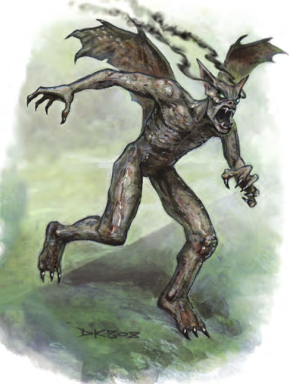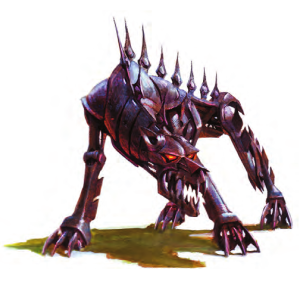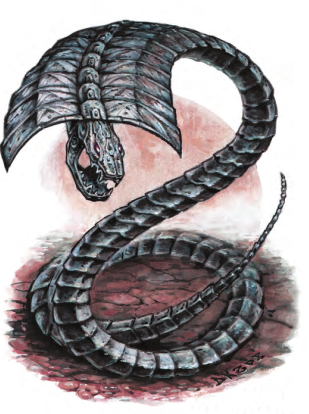Let's Read the 4e Monster Manual/Vault: Homunculus
This is part of a series! Go here to see the other entries.
I think Homunculi are derived from a medieval alchemy concept, and I’m pretty sure they’ve been in the game since AD&D. Here they appear only in the Monster Manual.
The Lore
In my post on Helmed Horrors I compared construct creators to real-world programmers. Let’s stretch the analogy a bit further: if golems and greater helmed horrors are big packages of enterprise software, then homunculi are shell scripts.
These minor constructs are built for the exact same purposes as their beefier relatives: to act as tireless guardians, servants, and muscle. Being low-level, I imagine they’re a lot easier to create, and their programming includes some “shortcuts” that make them particularly adept at a specific kind of guard job.
Mentally, they’re pretty much like golems: they can understand even complex instructions from their masters perfectly, and execute them without much thought of self-preservation unless specifically ordered to avoid taking damage. Unlike golems, though, ownership of an homunculus can be transferred to someone else with a simple order (“this person is your master now”). This means they’ll often be found in the service of someone who isn’t their creator.
So a low-level aspiring golem maker can have homunculi as servants, and higher-level casters who would use actual golems as personal guards can mass-produce homunculi and assign them to their underlings. The relative weakness of an homunculus is actually an asset here! If those pesky organic underlings start getting rebelious ideas, your personal guard-bot can easily squash them.
The Numbers
We get three quite diverse stat blocks here. They’re all Natural Animates with the Construct and Homunculus keywords, training in Perception, darkvision, and immunity to disease and poison. Everything else is variable.
Different types of homunculus gain special bonuses when tasked to guard a person, object or area. For rules purposes, objects can weight up to 50 pounds and areas can be up to 5 squares on a side. We’ll see why in a minute.
Clay Scout

This Small homunculus is probably the one closest to the classic myth. It’s used for, well, scouting, or for guarding small objects. I imagine it makes an adequate menial lab assistant if well-managed.
Clay scouts are Level 2 Lurkers with 31 HP and all common homunculus traits. They’re also trained in Stealth, and can run at speed 6 or fly at speed 3 (clumsy).
Scouts attack with a weak venomous bite that allows a secondary attack against Fortitude, which slows on a hit (save ends). They can attack at range using a Mind Touch (Ranged 10 vs. Will) which does adequate psychic damage and dazes (save ends). Mind Touch is clearly their main attack, with the bite being more of an emergency measure.
When targeted by a melee or ranged attack, they can use Redirect as an interrupt. This target’s the attackers Will, and on a success forces them to redirect their attack to an adjacent creature of the homunculus’ choice. Tricky!
They cap things off with a couple of interesting passive traits: clay scouts are invisible to dazed creatures and, if tasked to guard an object, gain a +4 to attack anyone adjacent to or carrying that object.
I think they’d mostly use their attacks to prevent pursuit in case they’re discovered spying on you. They’re big enough to carry most objects they could be set to guard, too. This is the construct you use when you want to carry something to the ends of the earth so it’s never found again.
Iron Defender

A metal guard dog, for when drakes aren’t enough but you don’t have the budget for a shield guardian. It’s a Level 3 Soldier with 47 HP and all common homunculus traits. It runs with speed 6.
It attacks by biting, and if tasked to guard a creature it can bite anyone who attacks that creature as a reaction. It can also shift 1 square before or after making opportunity attacks.
Iron Cobra

An homunculus named for its shape, not its role. As far as homunculi go, this is a high-end model.
It’s a Level 6 Skirmisher with 75 HP and all common homunculus traits. It slithers with speed 7, and can shift 3 squares as a move action.
They attack with a venomous bite that also does 5 ongoing poison damage (save ends), and it can poison its enemies’ minds as well.
Poison the Mind (Ranged 10 vs. Will; recharge 3-6) is an attack that can only target creatures suffering ongoing poison damage. The cobra’s bite is an obvious source of this, but if other venomous creatures are part of the same encounter their attacks also count. A hit dazes and slows the target (save ends).
When set to guard an area, iron cobras can use Poison the Mind without restriction against any creature inside that area. This means the attack effectively becomes at-will, and can target anyone in the area even if they aren’t taking poison damage.
Sample Encounters and Final Impressions
The sample encounter is Level 9: 2 iron cobras, 2 snaketongue warriors, and 1 snaketongue assassin. As expected, iron cobras are a hit with snake fanatics everywhere!
I think homunculi fulfill a necessary role for GMs who want to pit their PCs against constructs from an early point in the campaing. As we’ve seen already, golems and other similar constructs are usually too powerful to be fought by early-heroic tier characters.
I also like that their existence allows for that “construct-making as a parody of the tech industry” setting element I’ve been thinking about.